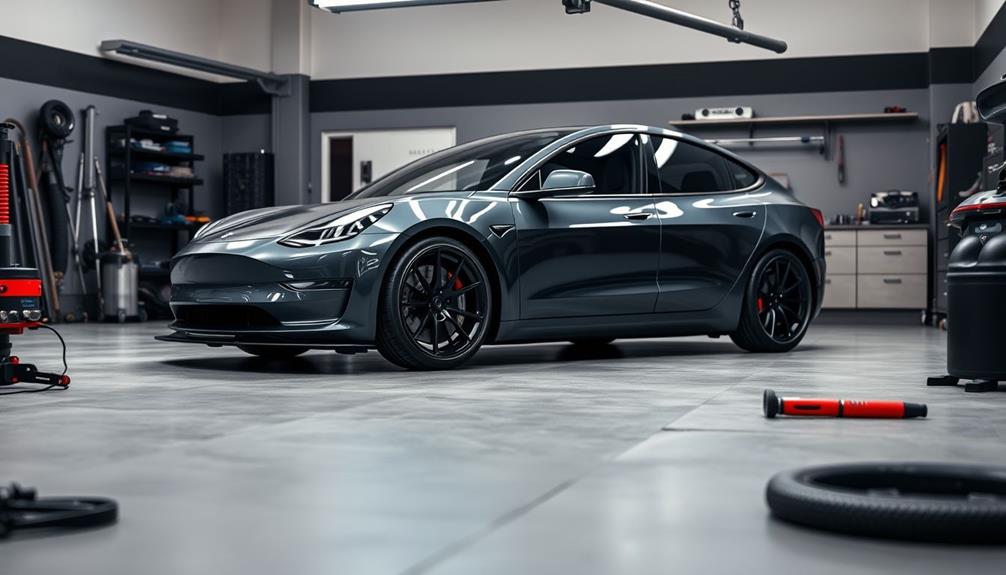If you've got a Tesla Model 3 and want to release its true potential, a tuning kit can help transform your EV into a performance machine. These kits can boost your horsepower by up to 150 HP, enhancing acceleration and driving fun. Installation is straightforward and often just requires a plug-and-play setup, making it accessible even for those with minimal mechanical skills. Plus, you can enhance handling with upgrades like luxury suspension kits. Just remember to check compatibility to avoid issues with warranties and firmware updates. Curious about the best options for your Model 3? There's more to explore! Consider researching different brands and customer reviews to find the best tesla tuning kit for your specific needs and preferences. These kits can also help improve your EV’s range and efficiency, adding another layer of value to your investment. With the right tuning kit, you can elevate your driving experience and enjoy the full potential of your Tesla Model 3.
Key Takeaways
- Tuning kits for the Tesla Model 3 can boost horsepower by up to 150 HP, significantly enhancing acceleration and overall performance.
- Easy plug-and-play installation allows users to upgrade their Model 3 with minimal mechanical knowledge required.
- Additional upgrades like Luxury Suspension Kits and adjustable sway bars improve handling and ride quality for a more responsive drive.
- Compatibility checks are essential to avoid voiding warranties and ensure the kit is suitable for your specific Model 3 variant.
- Installation may impact Tesla firmware updates, potentially affecting performance features, so weigh the benefits carefully before proceeding.
Overview of Tuning Kits
When it comes to enhancing your Tesla Model 3's performance, tuning kits are a popular option that can deliver impressive results. These kits can greatly boost your vehicle's horsepower, with upgrades like the Ghost providing an additional 150 HP.
If you're driving a dual motor Long Range variant, specific tuning kits are designed to optimize performance upgrades tailored to your vehicle's capabilities.
One of the greatest advantages of these tuning kits is their easy installation. Many options are plug-and-play, allowing you to upgrade without needing extensive mechanical knowledge. This means you can transform your Tesla Model 3 into a performance machine without the hassle of complex installations. Another benefit of these tuning kits is their compatibility with a wide range of Tesla models, including the Model S and Model X. With Tesla tuning kit upgrades, you can significantly improve the acceleration, handling, and overall performance of your electric vehicle. Plus, these upgrades are often reversible, meaning you can switch back to the original settings if desired.
Besides increasing horsepower, tuning kits often introduce exciting features like drift mode and custom lap mode, enhancing your vehicle's handling characteristics for track performance.
However, it's crucial to conduct compatibility checks before installation, as some options may void manufacturer warranties or impact future Tesla firmware updates.
Performance Enhancements

To elevate your Tesla Model 3's driving experience, performance enhancements play an essential role in accessing its full potential. With the right tuning kit, you can achieve an impressive acceleration boost, increasing horsepower by up to 150 HP. This significant uptick in power translates to improved acceleration, making your Model 3 feel even more exhilarating on the road.
Incorporating upgrades like the Luxury Suspension Kit and adjustable sway bars enhances handling and ride quality. You'll notice a more dynamic driving experience, allowing you to tackle corners with confidence.
Additionally, aerodynamic enhancements such as front splitters and rear diffusers reduce drag and increase downforce, ensuring better stability at high speeds.
Another key aspect of performance enhancements is the use of lightweight components, which improve acceleration and efficiency. As a result, your Model 3 becomes more responsive, giving you that thrilling drive you crave.
For those looking to customize their ride height, custom air ride suspension options provide up to 5 inches of adjustability, enabling you to fine-tune your vehicle's stance for either performance or comfort.
With these enhancements, your Tesla Model 3 transforms into a true performance machine.
Installation and Compatibility

Installing the Tesla Model 3 Tuning Kit is straightforward, thanks to its user-friendly plug-and-play setup. This design allows you to easily integrate the tuning kit into your dual motor Long Range Model 3 from 2018 to 2023 without extensive modifications.
However, it's essential to check your vehicle's compatibility before proceeding. The tuning kit isn't suitable for Model 3/Y performance versions or those equipped with the 4680 battery.
To assist you further, a detailed installation guide is included with the kit, and you can find helpful video tutorials on YouTube. These resources make the installation process even smoother, ensuring you get the performance enhancements you desire.
Keep in mind that after installation, you may lose the ability to receive Tesla firmware updates. This could impact your vehicle's performance and features, so weigh this decision carefully.
Frequently Asked Questions
How Do I Upgrade My Model 3 to Performance?
To upgrade your Model 3's performance, consider adding a Ghost upgrade for 150 horsepower or the Ingenext Boost 50 for 50 horsepower. Always check compatibility and consider professional installation for complex enhancements.
Can You Tune a Tesla Model 3?
Yes, you can tune your Tesla Model 3 with third-party upgrades, boosting performance considerably. Just be cautious, as these modifications might void your warranty and limit future software updates from Tesla.
How Much Horsepower Does the Tesla Model 3 Performance Mode Have?
Did you know the Tesla Model 3 Performance mode packs 450 horsepower? With its impressive acceleration, it takes just 3.2 seconds to hit 60 mph, making it a thrilling ride for performance enthusiasts like you.
What's the Difference Between Performance and Regular Tesla?
The Performance Tesla delivers faster acceleration, enhanced handling, and superior traction compared to the regular model. With upgraded brakes, suspension, and exclusive track mode, you'll enjoy a thrilling driving experience that's hard to beat.
Conclusion
In the world of electric vehicles, a Tesla Model 3 tuning kit can be your secret weapon, transforming your eco-friendly ride into a powerhouse of performance. While some see EVs as mere city commuters, you can elevate yours to a thrilling machine that zips past the ordinary. With the right enhancements, you're not just driving; you're commanding the road. So, embrace the fusion of sustainability and speed, and let your Model 3 redefine what it means to drive electric. With performance chip tuning for Tesla Model 3, you can unlock the full potential of your electric vehicle, pushing its boundaries and leaving traditional gas-powered cars in the dust. These enhancements can take your Model 3 to new heights, delivering an exhilarating driving experience that combines efficiency and adrenaline. So, don’t settle for an average EV experience; with the right tuning kit and performance chip, you can take your Tesla to the next level of power and excitement. Upgrade your Tesla Model 3 with the latest in performance technology and unleash its true capabilities on the road. With essential upgrades for your electric sedan, you can achieve unparalleled acceleration, handling, and overall driving performance. Don’t miss out on the opportunity to revolutionize your EV driving experience and leave a lasting impression with every journey. Don’t limit your Tesla Model 3 to the standard electric car experience. With highperformance EV upgrades, you can elevate your ride to a whole new level, experiencing the thrill of speed and power without sacrificing sustainability. Embrace the future of driving and maximize the potential of your electric vehicle with cutting-edge enhancements that will push the boundaries of what your Tesla can achieve. Don’t settle for average when you can transform your Model 3 into a high-performance masterpiece that redefines the electric vehicle experience.









